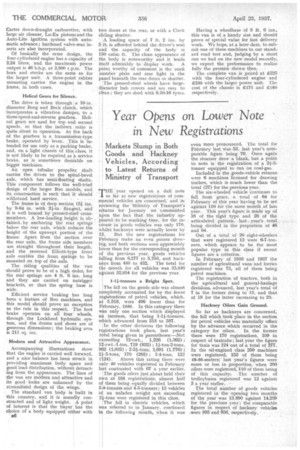Reo Introduces New 15-cwt, Model
Page 39

Page 40

If you've noticed an error in this article please click here to report it so we can fix it.
WHEN we described the latest Reo Vlf range in our issue dated February 5, last, reference was .made to the fact that a new 15-cwt. model would he available shortly. The first examples of these machines are now ready and it will be seen from accompanying illus
trations that the complete van, with its British-built body, is of distinctive appearance and sturdy design.
Appreciating the wide diversity of conditions under which a vehicle of this class is required to operate, Rey Motors (Britain), Ltd., Beavor Lane, London, W.6, has wisely decided to offer alternative engines, so that the requirements of all operators can be fully satisfied. Where economy is a primary consideration, the smaller unit will doubtless be the choice of the buyer, but for use in hilly country or for newspaper work, for example, the improved performance and big reserve of power of the larger engine are likely to be fully appreciated.
Designated models 475 and 675, the machines are identical, except for the power unit; the former is equipped with the four-cylindered engine and the latter with the six-cylindered unit.
Having a piston-swept volume of 3.42 litres, the six-cylindered Silver Crown engine develops a maximum of 70 b.h.p. at 2,800 r.p.m. ; the bore and stroke are Si mm. and 112 mm. respectively. The unit is equipped with a
Carter down-draught carburet er, with large air cleaner, Lo-Ex pistons and the Auto-Lite ignition system wi h automatic advance ; hardened valv -seat inserts are also incorporated.
Of basically the same design, the four-cylindered engine has a capacity of 2.24 litres, and the maximum power output is 46 b.h.p. at 2,800 r.pIrm. The bore and stroke are the same as for the larger unit. A three-poi it rubber mounting carries the engine in the frame, in both cases.
Helical Gears for Silen
The drive is taken through a 10-in. diameter Borg and Beck clutch, which incorporates a vibration damPer, to a three-speed-and-reverse gearbot. Helical gears are used for top an second speeds, so that the indirect .ratio is quite silent in operation. At he back of the gearbox is a transmis ion-type brake, operated by lever. Tijis is intended for use only as a parkixg brake, and, on a light chassis of thist. class, it is not likely to be required as service brake, as is sometimes desable on bigger 'machines.
An open tubular propell r shaft carries the drives to the spiral-bevel axle, which has semi-floating shafts. This component follows the ell-tried design of the larger Reo mo els, and its construction is such that it should withstand hard servide.
The frame is of deep section (54 ins. by 9-64 in. with 2k-in. flan es), and it is well braced by pressed-s 1 crossmembers. A low-loading height is obtained. by anchoring the rear springs below the rear axle, which reduces the height of the upswept portion of the frame. Apart from the section over the rear axle, the frame side members are straight throughout thehl length, and the reversed Elliott-type front axle enables the front springs to be mounted on top of the axle.
The riding qualities of he van 'should prove to be of a high 4rder, for the rear springs are 4 ft. 6 ins, long and they are carried on outrigger brackets, so that the spring base is wide.
Efficient service braking ltas long been a feature of Reo machines, and this model should prove no xception to the rule in this respect. irhe foot brake operates on all four wheels, through the Lockheed hydra ic system, and -the drums and sho s are of generous dimensions ; the braking area is 213 sq. ins.
Modern and Attractive App4Larance.
Accompanying illustrations show that the engine is carried well forward, and a nice balance has -been struck in providing maximum body space and good load distribution, withoul detracting from the appearance. Th lines of the van are modem and attractive and its good looks are enhanced by the streamlined design of the wii4gs.
The standard van body is built in this country, and it is soundly constructed and of light weight.. A point of interest is that the buyer has the choice of a body equipped either with
B6 two doors at the rear, or with a Clark sliding shutter.
A loading space of 7 ft. 2 ins. by 5 ft. is afforded behind the driver's seat and the capacity of the body is 150 cubic ft. The clean appearance of the body is noteworthy and it lends itself admirably to display work. A point_ worthy of comment is the sunk number plate and rear light in the panel beneath the rear doors or shutter.
The pressed-steel wheels have largediameter hub covers and are easy to clean ; they are shod with 6.00-16 tyres. Having a wheelbase of 8 ft. 6 ins., this van is of a handy size and should prove of special value for fast delivery work. We hope, at a later date, to submit one of these machines to our standard road test and, judging by a short run we had on the new model recently, we expect the performance to realize fully the promise shown then. The complete van is priced at £225 with the four-cylindered engine and £230 with the larger power unit. The cost of the chassis is £175 and £160 respectively.




























































































